Maryland Fishing Report – Oct. 21
The month of October is offering Maryland anglers some of the best fishing opportunities to be found at any time of the year. The fall trout stocking program is in full swing, other freshwater fish are feeding aggressively, and fishing for striped bass in the Chesapeake Bay is at its zenith.
As we all know, Maryland has taken numerous conservation measures to protect the Chesapeake Bay striped bass population. Anglers now have an opportunity to comment on striped bass closure period options for summer 2021. Comments must be submitted by 11:59 p.m. on Nov. 3, 2020. Read about the options and comment online at the Maryland Department of Natural Resources website.
Another beautiful week of Rocktober is ahead of us with stable and sunny to partly cloudy days, low winds, and cool nights, with a chance of rain on Saturday. Chesapeake Bay surface water temperatures are holding in the mid 60s and will remain stable this week. Local rivers are cooling faster than bay waters so there will be movement of some fish towards the bay as they prepare for winter in the warmer river mouths or just outside. The bay’s waters have adequate oxygen for Bay fish at all depths. This will result in cool-water preferring fish being able move throughout the water column. As surface waters continue to cool, deeper waters will remain slightly warmer. As a result of below normal flows from the Susquehanna River, main bay salinities are slightly higher than normal. As always, best fishing areas could be further refined by intersecting them with underwater points, hard bottom, drop-offs, and large schools of baitfish.
Expect average flows for most Maryland rivers and streams except for the lower Potomac and on the lower Eastern Shore. There will be above average tidal currents as a result of the new moon Oct. 16-17.
Expect temporary reduced clarity from algal blooms on the Northeast, Sassafras, Bush, Back, and upper Nanticoke rivers. To see the latest water clarity conditions, check Eyes on the Bay Satellite Maps.
For more detailed and up-to-date fishing conditions in your area of the bay, be sure to check out Click Before You Cast. Get regular updates on Maryland’s waters sent to your inbox with our Eyes on the Bay newsletter. Sign up online.
Flows from the Conowingo Dam and the lower Susquehanna River continue to be very low. There have been sparse power generation water releases for several weeks now, causing the river to flow low and clear. There is plenty of striped bass action at the dam pool, the lower river, and the Susquehanna Flats and nearby channel edges. Casting topwater lures in the morning and evening hours is producing a lot of fun catch-and-release action with striped bass just under the minimum length of 19 inches, but just enough larger fish to allow anglers to take one home if they wish.
As the day wears on, casting soft plastic jigs, Rat L Traps and similar type lures is a good bet along the channel edges near the Flats and in the lower part of the river. This time of the year, large smallmouth bass can be an unexpected surprise when jigging and a real catch-and-release prize.
Large numbers of blue and channel catfish are present in the Susquehanna and the lower Elk and Northeast rivers. Channel catfish can be found most everywhere, but the blue catfish seem to prefer the lower Susquehanna near where it flows into the bay. The area just below the railroad bridge tends to hold quite a few large ones. Fresh cut bait is the most popular bait, especially for the larger blue cats. Clam snouts, cut bait, nightcrawlers, and chicken liver work well for channel catfish.
There is plenty of striped bass fishing action in the upper bay region this week. Anglers are enjoying good trolling and jigging opportunities in many traditional locations. The shipping channel edges are a good place to troll a spread of umbrella rigs and spoons behind inline weights as well as bucktails and diving jerkbaits. Also whenever breaking fish can be spotted, trolling along the outside edges of the action — never through it — is a good tactic.
The mouth of the Patapsco River continues to be an excellent place to troll or jig. The areas around Swan Point and the Love Point rocks are great places to jig when suspended striped bass can be spotted. The fish are moving and can be found on any number of reefs, knolls, and the mouths of the Chester and Magothy rivers.
The Bay Bridge piers are always a good place to check for striped bass and this week is no exception. Casting skirted soft plastic jigs up close to the bridge piers, bridge abutments, and rock piles is usually a worthwhile endeavor. Large white perch can also be found holding near the piers and rock piles at the bridge. Small heavy metal jigs and dropper flies are the way to get to them.
White perch are moving out of the tidal rivers and creeks as water temperatures cool. Anglers are still finding some white perch in the shallower areas and catching them, along with yellow perch, on beetle spins. If the white perch are in deeper waters in the tidal rivers, bottom rigs baited with pieces of bloodworms or dropper rigs with small flies or jigs is the way to get to them.
Striped bass are spread throughout the middle bay, along the shipping channel edges and the lower sections of the tidal rivers. The striped bass can be found suspended along channel edges, spotted as breaking fish, or found in shallower areas along the shores in the lower sections of the tidal rivers. A large number of the striped bass being caught are undersized but there are enough keeper fish above 19 inches to make most anglers happy.
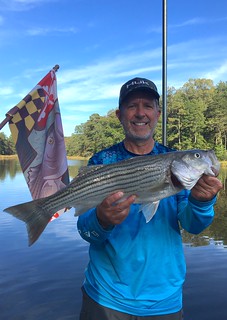
Herb Floyd holds up a nice striped bass he caught in the lower Choptank River on a jerkbait. Photo courtesy of Herb Floyd
Those trolling are mostly pulling umbrella rigs behind inline weights and using spoons or bucktails as trailers. The channel edges along the outside edge at Hacketts, the Gum Thickets, Thomas and Bloody points, Buoy 83, the False Channel, and the western side of the shipping channel from Chesapeake Beach south past Parker’s Creek. Trolling can also be productive in the lower portions of Eastern Bay and the Choptank, Severn, and West rivers.
Light-tackle jigging is offering plenty of action. Spotting diving seagulls and breaking fish offers a lot of excitement and fun when pulling up and casting soft plastic or metal jigs. Many of the breaking striped bass are undersized but there are plenty of fish above 19 inches. Bait in the form of bay anchovies and juvenile menhaden are moving out of the tidal rivers and being swept along by tidal currents where striped bass are waiting.
Striped bass can also be found in the shallower areas in the lower portions of the tidal rivers and bay locations such as Poplar Island. Casting topwater lures, jerkbaits, and soft plastic paddle tails is a wonderful way to fish with light tackle in the quiet of the river shores.
White perch fishing remains good in the tidal rivers and creeks. The perch are moving out into deeper waters but there are still some holding near piers and rocks. Fishing with grass shrimp or pieces of bloodworm are the best ways to catch them off piers and docks that are in deeper waters. The white perch that have moved out into the lower sections of the tidal rivers will be found holding over oyster reefs.
A mix of striped bass, bluefish, speckled trout, white perch, and spot are entertaining lower bay anglers this week. Striped bass are being found in the bay and tidal rivers, as are bluefish and speckled trout. Spot and white perch are being found in the lower sections of the region’s tidal rivers and sounds.
Trolling is good along the shipping channel edges in the main part of the bay and the channel edges in the lower sections of the Potomac, Patuxent, and Tangier Sound. Most are trolling with umbrella rigs behind inline weights with bucktails for trailers. Trolling bucktails, spoons, and hoses are also effective choices. When breaking fish or slicks can be spotted, trolling around the perimeters is a great way to target striped bass and bluefish. Many of the striped bass in the lower bay are undersized but there are enough fish 19 inches and larger for anglers to take a fish home.

Jim Livingston, his daughter and grandchildren with their haul of blue crabs for the day. Photo courtesy of Jim Livingston
Jigging is good for striped bass where they can be found suspended along channel edges in the bay or tidal rivers. Often larger striped bass can be found suspended close to the bottom under breaking fish –which are usually 2-year-old striped bass in the 16-inch to 18-inch size range — and bluefish. Speckled trout can also be a bonus when jigging close to the bottom. Both soft plastic and metal jigs are equally productive choices for jigging.
The shallower waters along the edges of the bay, Tangier Sound, and the lower sections of the tidal rivers are offering good shallow-water action this week. Topwater lures tend to do best in the shallower areas over grass, and jerkbaits, crankbaits, and paddle tails work well in slightly deeper waters around shoreline structure. A mix of speckled trout, striped bass, bluefish, and a few small puppy drum are all part of the mix.
Those wishing to catch some spot are enjoying the best the season has to offer, as the spot are at their season’s best in size and abundance. Spot are a wonderful eating panfish and if large enough can be filleted and they make a wonderful fish sandwich. Pieces of bloodworm on a bottom rig is the most popular bait and method to catch them. The lower Potomac and Patuxent rivers are full of them as is the Tangier Sound area. White perch and speckled trout can often be part of the mix.
Recreational crabbers are still catching blue crabs in the middle and lower bay regions, with a half to a full bushel being common per outing. In the upper bay there are still crabs being caught, but catches are usually being reported to be a few dozen per outing. Trot lines are still effective and many are reporting catching crabs in 6 feet to 10 feet of water. Collapsible traps offer a good way to crab in deeper waters. Razor clams have been the best bait to use, and they may be cheaper in price now that many commercial crabbers have switched to oystering.
The fall trout stocking program continues as thousands of trout are being stocked in put-and-take areas each week. The trout program expects to stock approximately 25,000 fish by the end of October. Do not miss out on the fun and be sure to take a young or inexperienced angler with you. It is one of the best ways to start fishing.
Catchable size trout are not the only trout being stocked this fall. In some of the more suitable trout habitat waters fingerling sized trout are often stocked. Last month 4,000 fingerling rainbow trout were stocked in the catch-and-release section of the Youghiogheny River, and 3,000 fingerling rainbows in the North Branch of the Potomac. It is hoped that many of these small trout will grow to full size on their own.
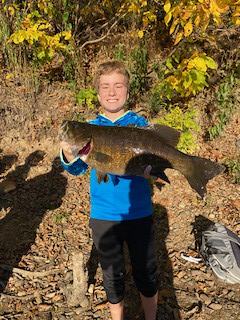
David Mirsky caught this huge smallmouth bass in the upper Potomac River recently. Photo courtesy of David Mirsky
To learn more about the fall trout stocking program you can also check out the recorded webinar of our recent Maryland Fishing Roundtable. Find this webinar along with other topics on the DNR Fishing Report page of our website.
Fishing at Deep Creek Lake is very good, as cooler water temperatures has caused many fish species to be aggressively feeding. Recreational boat traffic is down also making for a more peaceful experience. Northern pike are being caught in the more open areas of coves, and largemouth bass can now be found in slightly deeper waters holding near structure and drop-offs. Drifting along deep grass lines and fishing with live minnows is a great way to target large yellow perch and walleye. Smallmouth bass can be found along rocky points and any kind of sunken structure. A variety of jigs and small crankbaits that resemble crayfish are excellent baits to use.
The upper Potomac River is still running low and clear this week. Long casts, small lures, and light lines tend to offer the best chance of approaching smallmouth bass that are holding near current breaks, submerged ledges, and large boulders. The grass is declining and breaking up and leaves are falling, which can foul lines.
Largemouth bass fishing in nontidal and tidal waters is excellent. Any remaining grass, lily pads, or spatterdock fields are great places to target with stick worms, soft plastic baits, topwater lures, and jerkbaits. Sunken wood and the edges of drop-offs are great places to work with small crankbaits and jigs that resemble crayfish. In tidal waters the outside edges of spatterdock fields and feeder creek mouths are good places to cast spinnerbaits.
Fishing for channel and blue catfish is very good this time of the year in the middle to upper sections of the tidal rivers. Blue catfish are very abundant in the tidal Potomac, Patuxent, Susquehanna, and Nanticoke rivers and are expanding into every tidal river feeding into the Chesapeake. Fresh cut bait is hard to beat when fishing for blue catfish.
A summer survey of blue catfish revealed a few things about their feeding habits. All sizes of blue catfish were sampled and a few dietary standouts were menhaden, blue crabs, and crayfish.
Fishing in the surf for kingfish continues to be very good. Spot are also part of the mix when fishing with pieces of bloodworm. Bluefish are being caught on cut mullet or spot, flounder on squid or spot. A few large red drum are being caught on large cut baits and providing some exciting catch-and-release action.
At the inlet, fishing for flounder is very good as flounder make their way to offshore waters for the winter months. Casting and walking large Gulp baits across the bottom is an excellent way to catch the larger flounder, as is drifting live spot or mullet. Bluefish and striped bass are being caught in the inlet in the morning and evening hours by drifting live or cut baits and casting lures. Sheepshead are being caught along the jetty rocks on sand fleas and pieces of crab.
In the back bay areas of Ocean City and Assateague Island, the channels leading towards the inlet are among the better places to fish for flounder. Drifting traditional baits of squid and minnows or white or pink Gulp baits is a good tactic. At the Route 90 Bridge there is some striped bass action that is mostly catch and release. Most of the striped bass fall short of 28 inches but are fun to catch and release on light tackle. Casting topwater lures and paddle tails in the morning and evening hours is the popular way to fish.
The boats headed out to the offshore wreck and reef sites continue to find limit catches of sea bass for their anglers. Large flounder and triggerfish are also part of the daily catches. Those heading farther offshore to the canyons are catching a few bigeye tuna, but tend to be focusing on fishing the deep for swordfish and blueline tilefish.
“A fisherman is good in proportion to the satisfaction he gets out of his sport. So a merry duffer is better than a dour master.” — Roderick L. Haig-Brown
Maryland Fishing Report is written and compiled by Keith Lockwood, Maryland Department of Natural Resources fisheries biologist.
Click Before You Cast is written by Tidewater Ecosystem Assessment Director Tom Parham.
This report is now available on your Amazon Echo device — just ask Alexa to “open Maryland Fishing Report.”

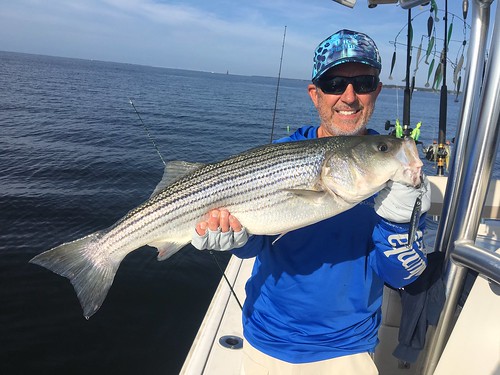
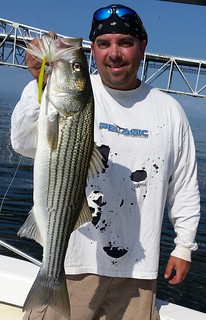
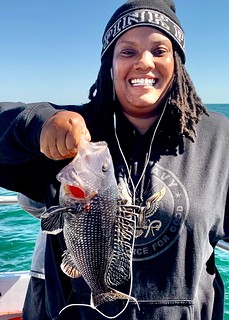
 1-888-373-7888
1-888-373-7888 233733
233733